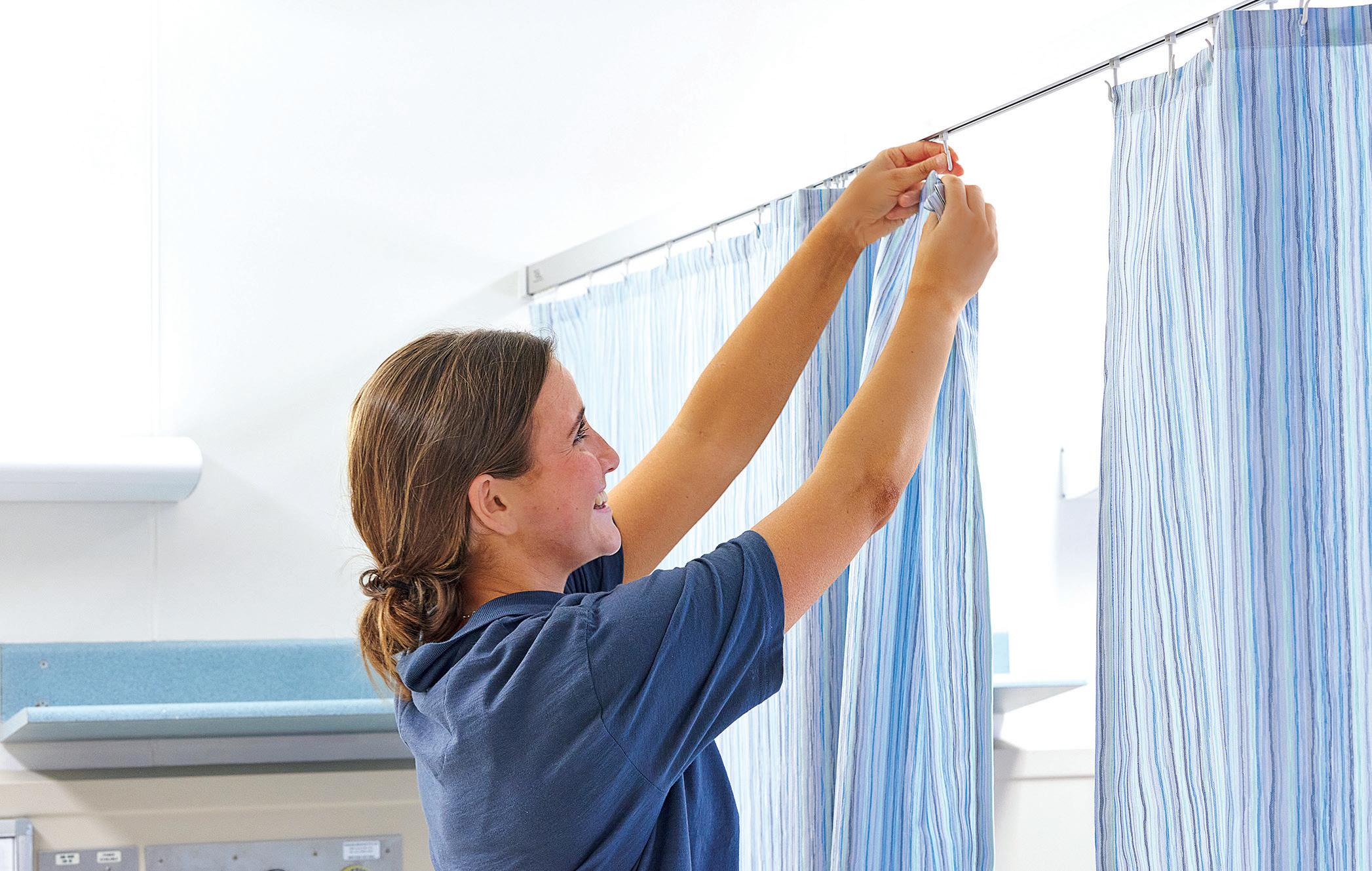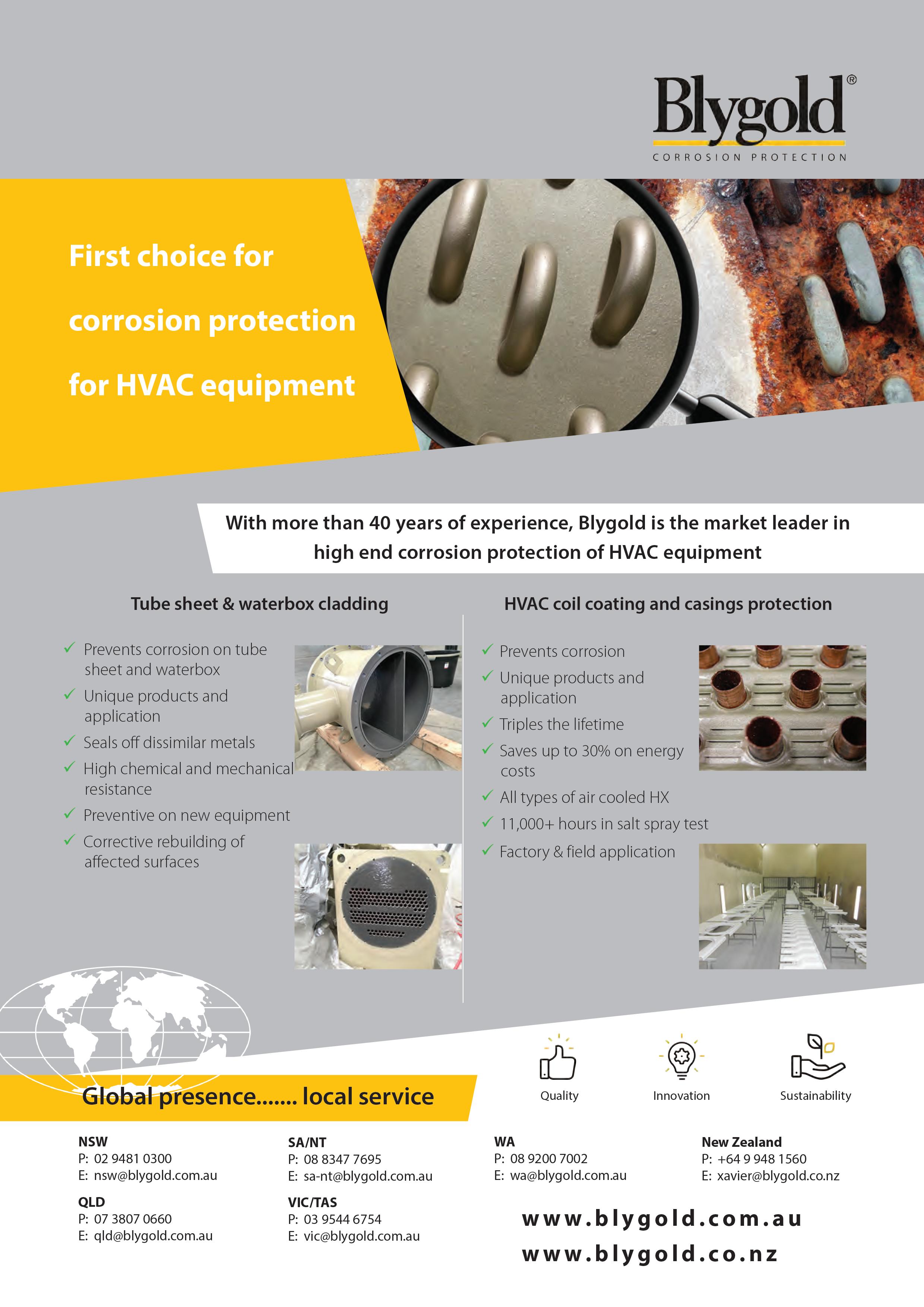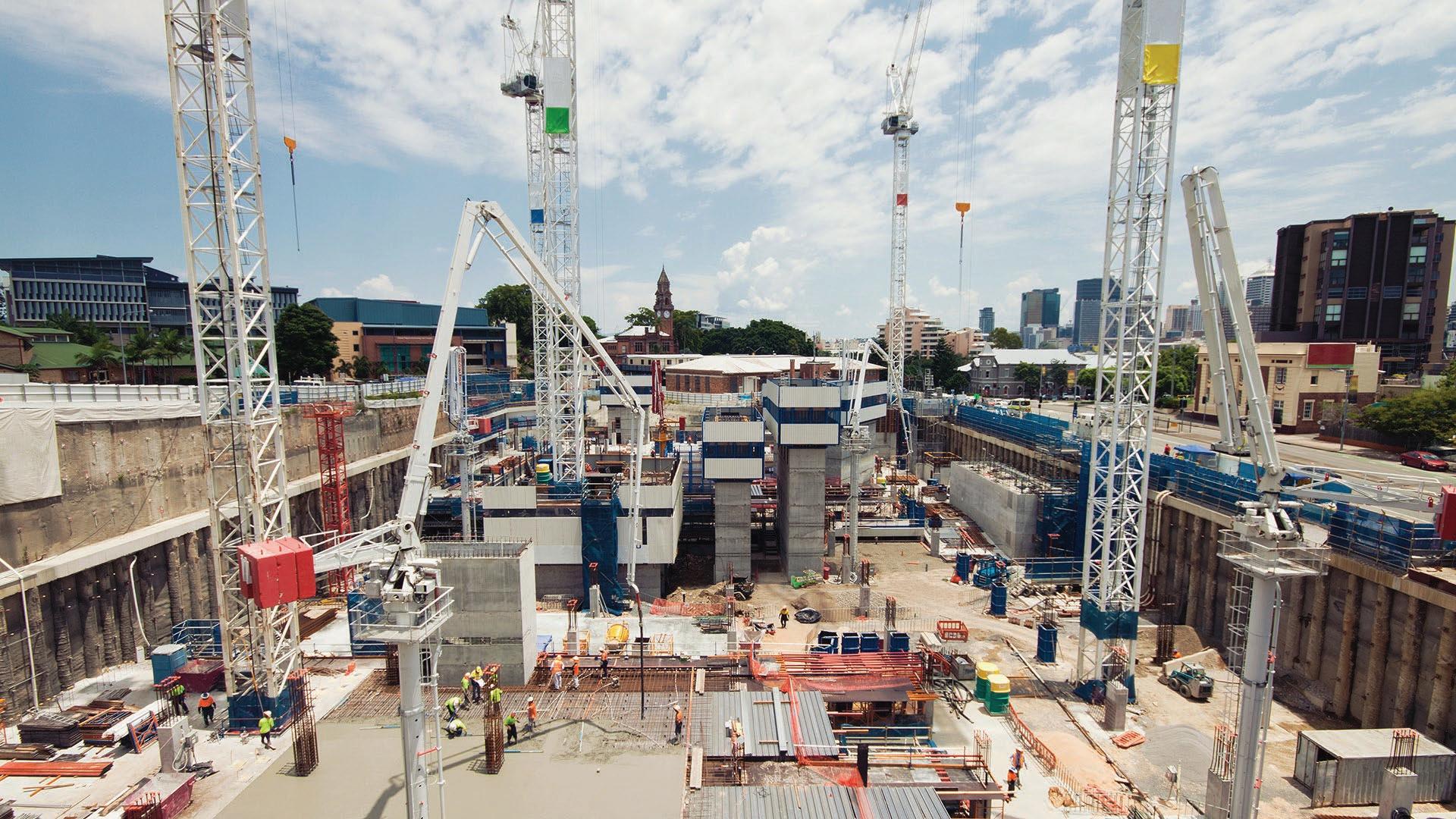
18 minute read
Innovations in Indoor Air Quality (IAQ) Management for Healthcare Environments
Dr Michael Taylor Practice Manager – OHYG and Principal Mycologist, Greencap
Julie Sullivan Team Manager – OHYG, Greencap
An acute focus on indoor air quality, particularly relating to infection risks over the COVID-19 pandemic period, has heightened the awareness of the impact of airflow and aerosol transmission within workplaces. Guidance has been provided by the World Health Organization (WHO), Centers for Disease Control & Prevention (CDC), SafeWork Australia and other agencies to adjust the existing ventilation and filtration systems with the goal of reducing infectious potential.
Many facilities have attempted to incorporate the guidance to reduce infection risks with increased or altered ventilation rates, increased fresh air provision, heightened filter efficiencies and added non-standard air treatment (disinfection or purification) devices. Verification of these adjustments has brought with it a heightened requirement for insight into real-world, high-resolution information and tools to help guide building managers and engineers.
This paper will discuss some of these interventions and alterations to air handling, and provide discussion of a novel DNA based system for rapid, high-resolution insight into the air quality in healthcare facilities.
Infection prevention and aerosol-based hazards
The rapid emergence of SARS-CoV-2 infections in early 2020 produced a significant interest, both public and professional, in disease transmission routes, with early conclusions made that the primary transmission route of SARS-CoV-2 was surface borne, or by respiratory droplets and less attention given to aerosol generation and transmission. However, these early assessments were subsequently revised to demonstrate that aerosol transmission was the key driver of COVID-19 infections, precipitating a rapid shift in focus from fomite transmission and cleaning activities, to airflow, ventilation and filtration-based investigations and interventions.
Whilst historic publications on viral transmission are plentiful, never had such a large real-world series of observations been possible. Emerging publications demonstrated that the most efficient route of transmission was via direct contact with exhaled respiratory droplets which are generated when an infected person exhales, coughs, talks, sings etc (Liu et al., 2020; Chan et al., 2020; Burke, 2020; WHO, 2020; Hamner, 2020; Ghinai et al., 2020; Pung et al., 2020; Luo et al., 2020). Whilst these droplets contain infectious viral particles in high concentrations, they do not travel long distances and many of them fall to the ground with 1.5-2 metres of the infected person. It was suggested at this early stage that these droplets may travel further when an infected person yells, coughs or sneezes and in some circumstances may give rise to infectious aerosols, smaller droplets which remain airborne and infectious for longer periods of time.
Over time, a greater focus was given to the role of aerosol transmission of COVID-19 and the role of ventilation in propagating conditions amenable to airborne spread over distances greater than 1.5 metres. Heightened infection risks were noted where aerosol generating procedures were being carried out, such as in healthcare settings, or during gatherings in enclosed or crowded spaces attended by infected people (Leclerc et al., 2020), such as during choir practice (Hamner, 2020) in restaurants (Lu et al.; Fisher, 2020) and in conditions conducive to creation and maintenance of aerosols such as abattoirs (Middleton, Reintjes and Lopes, 2020). Whilst the current rate of infections of COVID-19 has reduced due to our recognition of these aerosol risks, our attention on improving indoor air quality in healthcare facilities should extend beyond
the current pandemic to both prepare for future emergency situations, but also to address the constant challenge of hospital acquired infections.
Nosocomial pneumonias are a serious risk to patients, especially those with haematological malignancies and in immunosuppressed groups. While invasive devices and procedures are the most common infection pathway for hospital acquired infection, airborne transmission of contaminants is a significant risk factor. As an example, in 2015-2016, 17,854 cases of hospital acquired pneumonia were reported in Australia (Independent Hospital Pricing Authority – AU, 2018), at an estimated additional cost of $39,406 per patient. Maintaining adequate ventilation and air filtration performance within internal healthcare settings is therefore essential to ensure healthy and safe spaces for all, particularly with a newly heightened expectation for healthcare and aligned facilities to investigate their HVAC setup and enact changes to reduce the risk of aerosol transmission. However, a distinctly limited set of tools exists to interrogate the movement of air and aerosols through a system, generally leading to interventions made with a lack of accurate observational data.
Appropriate ventilation design in healthcare settings requires air change rate of 6-20 air changes per hour (ACH), in addition to appropriate layout and extract positioning to minimise stratification, poor mixing of fresh and recirculated area, dead spots (areas of low air flow), or migration of air outside of containment zones for isolation rooms.
Existing technologies
A range of established technologies and methodologies exist to improve air quality and mitigate infection risks from aerosolised contaminants. All have value and can be used to great effect, but when implemented incorrectly, or not verified once operational, these techniques can prove ineffective, costly and in some cases, actually detrimental to internal air quality.
Filtration & HVAC setup
The setup and operation of ventilation and filtration systems relies upon a balance of the amount of air passed through the system or space (and from this calculated air changes per hour, ACH), temperature and humidity control, and the filter rating. Calls for facilities to increase the amount of fresh air introduced into their HVAC systems, or to increase the number of ACH are often met with a poor system (increased humidity) or efficiency outcomes as energy costs dramatically increase with each ACH, and may shorten the life of plant and equipment now placed under significant additional load.
How are you Managing Infection Control?
Holistic infection control in healthcare facilities requires consideration at all stages of the facility’s lifecycle; particularly during construction, renovation or maintenance works.
Greencap’s services include:
• Infection Control, H&S Frameworks & Assurance Programs • Occupational Hygiene Assessment & Monitoring • WHS Management System Design & Implementation • Contractor Management Frameworks • Property Risk Auditing & Facility Management • Indoor Environmental Quality & Ventilation Assessments

Scan QR code to learn more, or visit:
greencap.com.au/infection-control


These recommendations, although likely beneficial if implemented correctly, are often made without insight into the existing system efficiency and operation, and without considering the range of intermediate interventions that may be made ahead of costly or unnecessary technical alterations to a HVAC system.
Ventilation and filtration of internal air can be adjusted via changes to existing HVAC operating parameters, for example by increasing fresh air intake ratios, or upgrading the specification (Minimum Efficiency Reporting Value, or MERV rating) of filtration media to capture the virus and preventing it from recirculating. However, this can result in reduced air flow if the HVAC system operates outside of designed ranges, along with associated increases in energy consumption and costs. Installation of portable HEPA air filtration units is another method to improve local air quality, but the benefits of this technology may be marginal in comparison to the high capital and operational costs, especially if not sized and placed appropriately in the space.
Finally, the use of physical barriers to alter and segregate air circulation pathways within internal spaces is a wellrecognised mechanism to reduce person-to-person airborne transmission of aerosolised contaminants. This technique however may generate other detrimental impacts to occupants, and is often not practical in operational healthcare settings.
UV lights
Ultraviolet radiation in the UVC spectrum (200-280 nm) has been extensively employed as an antimicrobial treatment of air, water and materials and has a demonstrated efficacy as observed by decades of data (Kowalski, 2010; Bolton and Cotton, 2011). This efficacy however still relies upon the appropriate application of UVC at sufficient power for sufficient time to cause damage to the microbes it is attempting to damage or kill. UVC exerts a detrimental effect on microbial cells and viruses as the RNA, DNA and many intracellular proteins absorb light in the spectrum of 200–280 nm (Bolton and Cotton, 2011; Kowalski, 2010).
The required doses of UVC for inactivation of SARSCoV-2 have been proposed, based upon both contemporary work studying the current pandemic strain, as well as historic coronaviruses and model strains, which typically require an order of magnitude greater dose than those reported for MS2 (Tseng and Li, 2005; Walker and Ko, 2007). Proposed doses to
Table 2: Proposed UV dose required to achieve suitable reduction in infectivity of coronaviruses.
achieve at least single log reduction (>90%) in viral infectivity will be dependent on the initial viral concentration, but a conservative dose of at least 20 mj/cm2 has been proposed to achieve a 4 log (99.99%) reduction in viral infectivity. A brief summary of studies demonstrating the effect of UV on disinfection of SARS-CoV-2 and comparable coronaviruses is presented in Table 2.
For UV air treatment, the effect of particulate load plays a strong influence on the total UV dose received by targets, with shadowing and scattering of UV light greatly decreasing the total absorbed dose. The inclusion of a HEPA filter may dramatically increase the efficacy of a UV light air treatment unit.
Bipolar ionisers
The observation that charged airborne ions influence the sedimentation rate of airborne particulate has existed in the scientific literature for well over 100 years, with studies specifically on interactions between charged ions and bacterial growth existing since the 1930’s (Tchijevsky 1933).
The use of industrial and more recently personal ionising devices has been studied extensively and consistently demonstrates that when an appropriately powered and sized ion generating device is used, there is a significant measurable decrease in many airborne particulate fractions, and some volatile organic compounds (Daniels 2002).
The basic principle of operation of these devices relies upon the application of an electric current to an electrode sufficient to generate a discharge which ionises the surrounding air, resulting in the production of charged ions, with the increasing generation of ozone occurring at higher voltages. The ions generated will interact/attract both each other and with aerosols to form larger agglomerations which more rapidly sediment and drop out of the air column (Fletcher et al. 2008; Lee, 2008).
Outside of a laboratory setting both the Centre for Disease Control (CDC), and The American Society of Heating, Refrigeration and Air Conditioning Engineers (ASHRAE) still consider bipolar ionisation an ‘emerging technology’ and state that: [Bipolar ionization] Systems are reported to range from ineffective to very effective in reducing airborne particulates and acute health symptoms. Convincing scientifically rigorous peer-reviewed studies do not currently exist on this emerging technology; manufacturer data should be carefully considered (ASHRAE 2021).
Virus Wavelength
SARS-CoV-1 Undefined biosafety cabinet UV lights
SARS-CoV-2 254 nm
SARS-CoV-2 254 nm
UV dose (mj/cm2) Log reduction Study
120 5 (Kariwa, Fujii and Takashima, 2006)
20
40 4 (Patterson et al., 2020)
6 (Patterson et al., 2020)
Contemporary Observation and Verification Methods for HVAC systems
Although such a variety of HVAC setups and interventions exist, their suitability and cost/benefits are likely not clear or assumed in many instances. To verify whether ventilation and filtration technologies are adequate and fit-for-purpose, both from a general indoor air quality (IAQ) perspective, and specific to infection prevention, it is necessary to undertake quantitative assessment of the HVAC system and the associated areas serviced.
Depending on the nature of the system, these assessments can be used to: establish baseline conditions for existing engineering controls and HVAC systems; identify high-risk aerosol transmission routes; assess the integrity of containment barriers during construction or renovation works, or model the speed at which aerosolised contaminants dissipate in smaller, enclosed spaces.
Typically, these assessments use observational methods such as velocity measurements at air register outlets and temperature and humidity measurements. More quantitative investigations employ tracer gas monitoring, particle challenge testing and computational fluid dynamic (CFD) modelling. However, each of these comes with certain limitations or assumptions.
Tracer gas analysis, using compounds such as Sulfur hexafluoride (SF6) provides a much more direct measurement of ACH and airflow movement when applied by a skilled consultant, SF6 however, does not mimic the movement of particulate contaminants, is a potent greenhouse gas, and is substantially heavier than air.
Carbon dioxide (CO2) gas tracing is notably less expensive and more available than SF6 and similarly the field detection equipment is significantly less costly. This has lead to CO2 monitoring or gas tracing being frequently recommended as a surrogate measure of ACH. However, due to the natural presence of CO2 in air and exhalations of the occupants, results are frequently misinterpreted, for example an area with very poor air mixing rates may paradoxically show low CO2 if the gas source is not able to disperse throughout the building/room. As with SF6, CO2 tracing also only assesses adequacy of ventilation and does not verify filtration due to the gaseous nature of the compound.
Conversely, particle challenge testing is able to assess filtration by the generation of relatively short-lived test aerosols comprising of sub-micron particles, such as Poly Alfa Olefin (PAO) to evaluate the integrity of high efficiency particulate arresting (HEPA) filters, but is less suited to assessing ventilation.
An adjunct to these on-site measurements is the use of computational fluid dynamics (CFD) modelling, which is typically based on assumptions derived from design specifications, and may not be representative of actual onthe-ground conditions, or may be conducted using theoretical ventilation rates without on-site measurements.
Emerging monitoring and verification technologies
An emerging verification technology, which has shown promise in hospital and infection prevention and control studies, utilises a water-based synthetic DNA marker compound to model aerosol movement in internal spaces.
This process, veriDART™ by SafeTraces, was developed with support from the National Institutes of Health (NIH USA) and uses non-hazardous DNA-tagged aerosols dispersed by a nebuliser designed to mimic the poly-dispersive range of particle sizes released by coughing or sneezing. After a defined period of circulation, sampling of the aerosolised particles is carried out at specific locations via the use of static air sampling pumps and filters. Samples are analysed by quantitative polymerase chain reaction (QPCR) to determine the concentration of DNA marker compound at each sampling location. From these results, the log10 reduction of the DNA signal can be calculated moving away from the origin point. The sampling data collected is then used to generate heat maps or dilution curves to identify efficacy of existing ventilation and filtration controls and protocols. In healthcare settings or in areas where infection prevention is a specific objective, a reduction target of 99.9% decrease in DNA signal intensity over a defined time period can be established as an adequate endpoint for certifying a HVAC setup.
There are three principal performance assessments which this technology allows end users to assess:
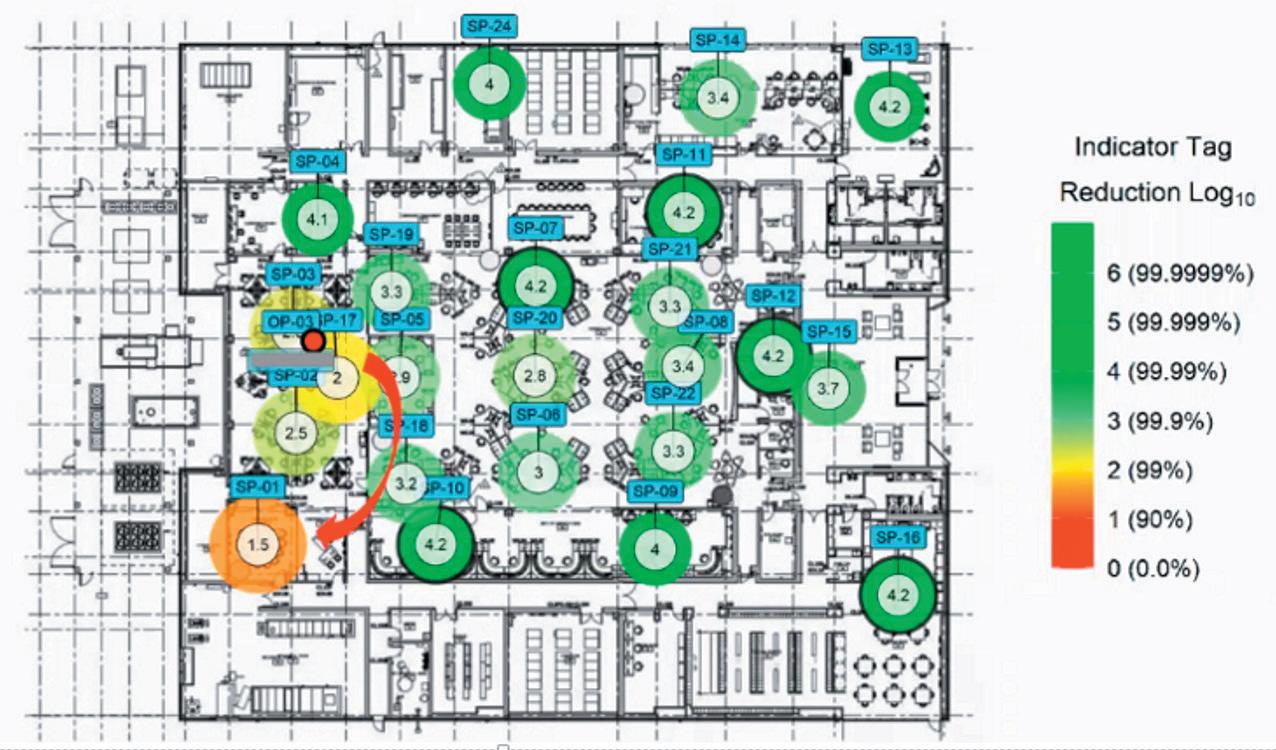
Survey test (zone or floorplan focused assessment)
Dilution test to determine the timeframe and required conditions for aerosol contaminants to dissipate in a room, and
Recirculation / Filter Challenge test (assessing filter performance for aerosol contaminants).
open weave for top 45 cm and bottom, allowing for air flow, and • Scenario 3 - Scenario 1 conditions with a portable HEPA filtration device.
Scenario 2 (closed curtain) delivered comparable performance results to Scenario 3 (HEPA filtration) after
Survey testing
Survey tests model the movement of aerosolised particles and indicate how the aerosol will behave under current engineering controls and HVAC system operating parameters, and can be used to identify ‘hotspots’ or high-risk areas where aerosols accumulate or do not disperse. Survey tests can be scaled with multiple origins and detection points, e.g., chosen beds within a ward, as required to achieve measurement objectives.
In the case below provided by SafeTraces, the assessment identified a hotspot where aerosol contaminant migration occurred from an open plan area to an enclosed space, in preference to the open plan area adjacent to the origin point.
Dilution testing
Dilution tests are used to verify the time and controls required to effectively reduce exposure risk to an acceptable level within enclosed spaces or rooms. The data generated can be used to compare existing ventilation system operation parameters against ventilation conditions once additional air filtration or air mixing conditions are applied to a system (for example, via portable HEPA filtration units, doors open/closed or increase fresh air intake percentages for HVAC systems).
In the hospital setting below (provided by SafeTraces) of a double occupancy patient room with a curtain divider between patients, a dilution test was integrated with a survey test to determine if the centrally provided ventilation and filtration was adequate, or if supplementing with portable HEPA filtration devices was justified from both an infection control perspective and on financial grounds.
Three scenarios were tested as follows: • Scenario 1 - Centrally provided ventilation and filtration (with an air change rate of 13 ACH in the patient room) • Scenario 2 - Scenario 1 conditions with a curtain dividing two patient beds (curtain was
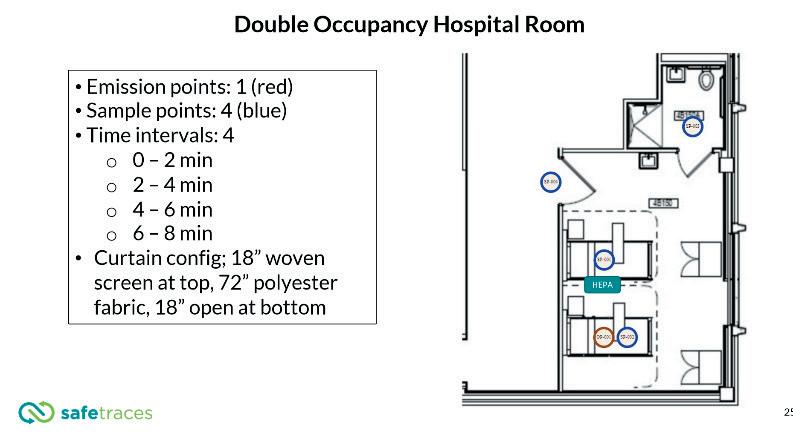
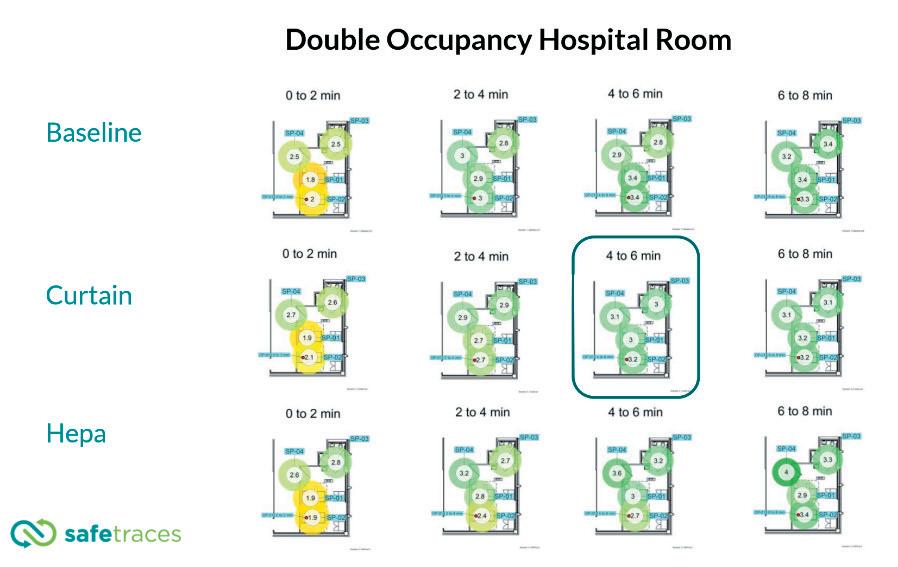
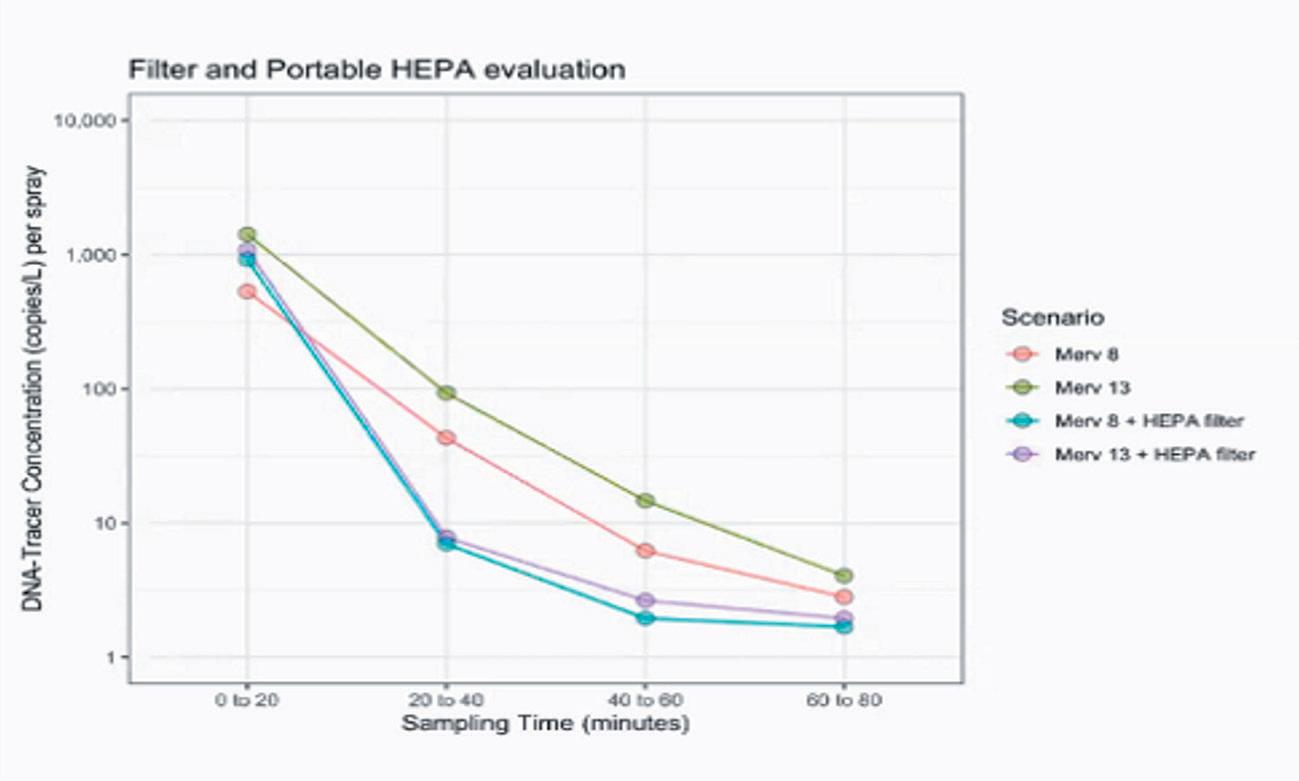
8 minutes, and achieved faster dissipation of aerosols than Scenario 3 after 4 to 6 minutes, clearing aerosols by 99.9% at all sample points.
Subsequent testing revealed that the portable HEPA filtration device chosen for the assessment had not been optimally sized and specified for the room. The selection of an inadequate or inappropriate retrofitted filtration device is a common occurrence, and frequently during procurement inadequate consideration is given to the noise generated by portable HEPA filtration devices and additional operational energy consumption.
Recirculation/Filter challenge testing
Filter efficiency testing can be used to assess filtration adequacy prior to capital outlay, or to measure the impact of retrofitted filtration upgrades following implementation. The example shown below compared MERV8 to MERV13 filters in the HVAC system alone, and then again in combination with portable HEPA filtration devices.
The application of veriDART™ in the above study provide by SafeTraces found that the portable HEPA filtration devices significantly reduced tracer concentrations when compared to using either MERV 8 or MERV 13 in isolation, indicating that the additional impact of MERV 8 or MERV 13 was likely negligible.
Conclusion
The vast assortment of available technologies, HVAC system design setups and facility layouts frequently results in an over or under estimation of the risk boundaries around aerosol migration and infection transmission potential, with little observational data to support these assumptions. Insight into the true function of healthcare HVAC systems is a critical step to improve infection prevention and control efforts.
The rate of preventable nosocomial respiratory infection (pneumonia) presents a significant risk to immunocompromised groups, and can be reduced by insight into the operation of HVAC systems and aerosols within facilities by applying emerging technologies to investigate key airflow processes.
SafeTraces veriDART™ provides some advantages over conventional gas tracing studies, and can assist in the optimisation of HVAC systems and completion of quantitative cost benefit analyses of system modifications.
Are your Clinical Areas Compliant?
Patient Treatment Areas
(including Body & Cardiac Areas) must be tested annually & meet Australian Standards.
Let us take care of your electrical compliance needs & ensure your patients & staff are safe.
GOLD
EV CHARGING SOLUTIONS MEDICAL ELECTRICAL SPECIALISTS
We are the electricians of choice for healthcare facilities across WA.
From install & commission to certification & compliance, Foster’s Services is your turn-key solution.
We specialise in delivering medical electrical services for public & private facilities including:
■ Hospitals ■ Medical clinics ■ Day surgeries ■ Allied health ■ Dental ■ Metropolitan & Regional facilities.
P. 08 9337 3315 E. service@fosters.net.au W. www.fosters.net.au
BLOX BY MATERIALISED
A SUSTAINABLE CUBICLE SCREEN SYSTEM
Developing a non-disposable cubicle screen has been Materialised’s passion for over 18 months. So, what was the motivation behind their new patented privacy screen system? 800,000 tonnes of textile waste are sent to landfill annually and hospital waste, through an obsession with ‘disposableeverything,’ is eye-watering. An entire industry has effectively been shipped offshore, along with thousands of jobs. With a history of supplying textiles to healthcare facilities, Materialised could no longer sit back and watch this situation worsen.
THE RESEARCH
Materialised set on an investigation journey to get a true understanding of what is driving the disposable screen fetish. Virtually every level of the hospital hierarchy was consulted to gain knowledge with which to formulate a solution. A module approach was examined, and road tested to eliminate concerns with OH&S, antimicrobial durability, laundry cost, inventory management, logistics, and cost. And the result? The result is named BLOX.
WHY CHOOSE BLOX
BLOX is a patented, modular, non-disposable cubicle screen system. It is a sustainable alternative to single-use disposable cubicle screens. These high-quality screens are made using a modular design to fit all requirements and can be installed on any hospital tracking system. Best of all, they are Made Down Under, keeping jobs and dollars in Australia. Lightweight 1.1kg BLOX modules are 2x2m, flame retardant and can be cleaned individually as needed, improving asset management. Silver Ion antimicrobial technology is built into the fibre to ensure life-long efficacy. They contain 50% recycled yarn, are fully recyclable and upcyclable. No landfill! BLOX is a win for everyone... Patients, facility operators, laundries, staff, our country, and our planet!
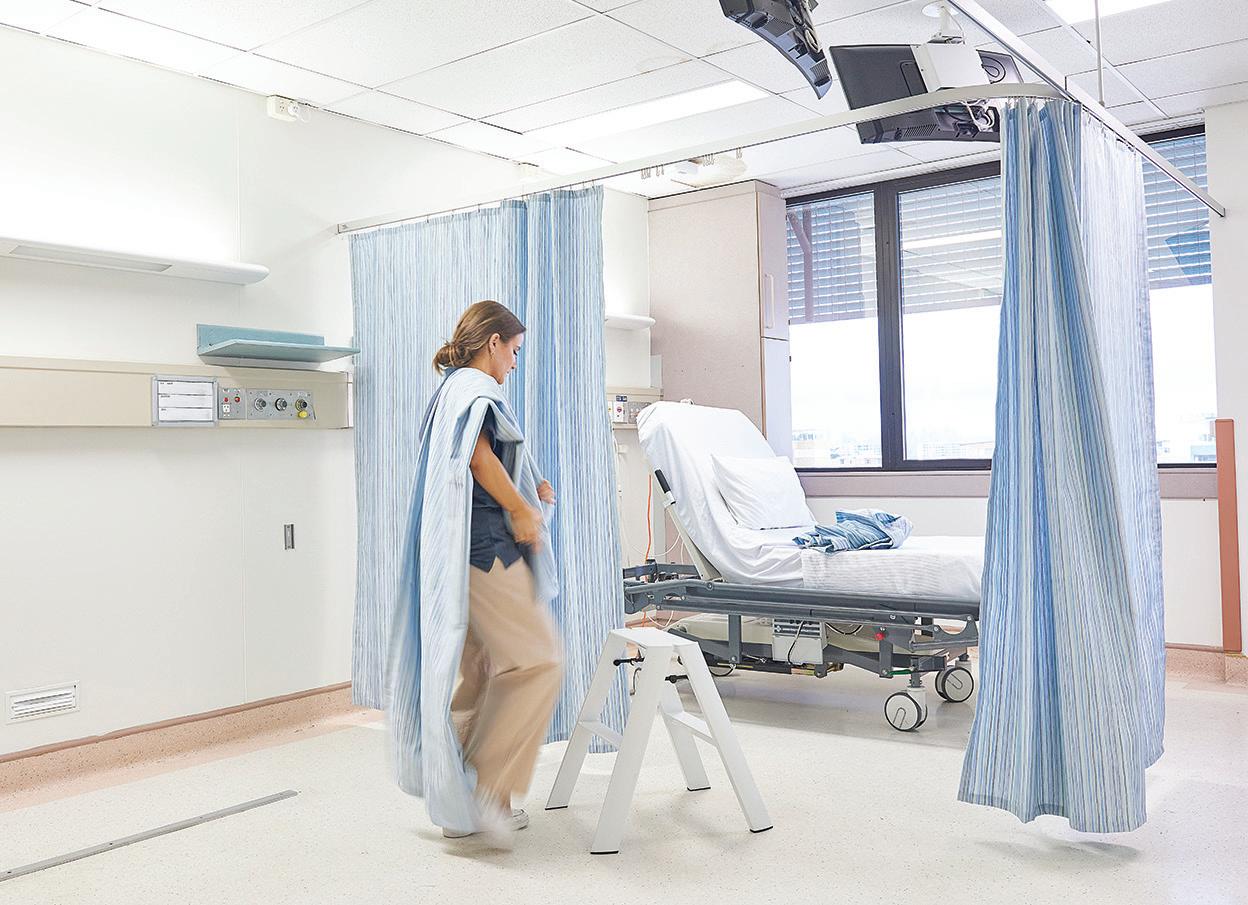
To learn more about BLOX visit materialised.com/blox, call +61 2 8558 3500 or email sales@materialised.com
MADE DOWN UND E R
